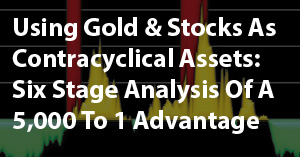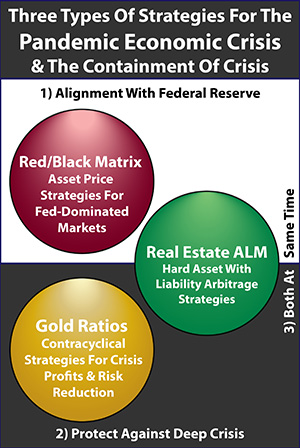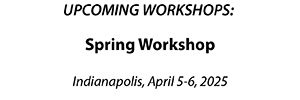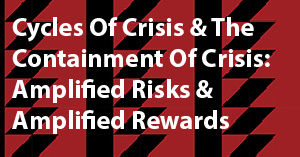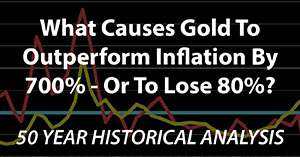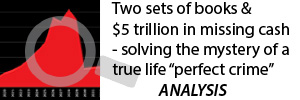Three Paths For Massive Monetary Creation In A Pandemic World
By Daniel R. Amerman, CFA
Tweet(The analysis below was prepared for an upcoming workshop. After working on it for several days, I realized that what I was putting together in the analysis is important for a lot more people than just those who will be at the workshop. If you are interested in the May workshop, great, there is a brochure linked at the end. For the many, many more people who won't be going, then just ignore the workshop references and keep reading, I think the three potential monetary paths have a great deal of applicability for all of us in 2021 and 2022.)
The economy & investment markets in early 2021 have traveled to an entirely new place, with both risks and opportunities that we have never seen before.
The U.S. (and world) economy and markets are now entirely dependent on a historically unprecedented degree of monetary creation that is being used to prop up markets and pay for the massive Federal stimulus spending that is effectively all that is preventing an economic and market collapse.
Ironically, however, few people understand how this is actually being done, or more importantly, the very real limitations of that process. So long as it works in its current form - we have a fantastic flow of money that seems able to materialize out of nowhere in endless amounts. This new monetary creation is what is now supporting consumer spending and lifestyles for the nation, as well as the record stock, bond and real estate prices that seem to be almost entirely disconnected from the disastrous state of the underlying economy.
What is holding the economy and markets together is the much larger 2020s variant of a new form of monetary creation, reserves-based monetary creation, that was first introduced in the U.S. in October of 2008 (this is NOT the traditional fractional reserve banking, but something quite different and is limited to central banks). At that time, the newly created money was used to rescue the global financial system. With very little coverage from a press that was distracted by the much less important TARP program, it is arguably only this unprecedented degree of monetary creation from a new source that prevented the collapse of the global financial system by November of 2008.
When it was successive waves of QEs, quantitative easings, that transformed the financial markets in the 2010s, it was reserves-based monetary creation that was paying the bills, coming up with the necessary trillions of dollars to fund the QEs, but doing so in a manner that did not create high rates of inflation.
When the economic shutdowns associated with the attempted containment of the spread of the COVID pandemic created extraordinary job losses - it was the swift and massive use of this new form of monetary creation that paid for the spending that is still all that holds the markets and the economy together today
First and foremost, every participant at the May workshop will understand exactly how reserves-based monetary creation works, both in its form before the pandemic, as well as the new form it has taken on due to the massive scale of the current crisis. In a back-and-forth discussion atmosphere, with frequent questions and answers, we will walk through exactly where the money has really been coming from - as well as the limitations of that process.
Indeed, there are multiple “moving parts” here, and instead of the awesome power of endless money creation that the Fed and the Treasury are trying to project - there are multiple potential sources of failure, even in 2021. Metaphorically speaking, there were a good bit of rubber bands and duct tape that were involved in the hasty assemblage under emergency conditions of what is effectively a new monetary system in 2020. There is also a good bit of smoke and mirrors going on, particularly when it comes to the relationship between the Federal Reserve and the U.S. Treasury Department, the monetary creation and the national debt. (There are very good reasons why Obama’s Fed Chairwoman is Biden’s Treasury Secretary, as the Fed funds the Treasury while the Treasury props up the Fed.)
Exploring Three Paths For 2021 & Beyond
Path #1: Everything Holds Together
Reserves-based monetary creation provided the money to get through the Financial Crisis of 2008, the repeated problems of the early 2010s in particular, and even funded the rapid growth in the national debt in the midst of the repo crisis of 2019. To date it has successfully funded much of the cost of the attempted containment of the pandemic crisis.
As we will explore using the very specific knowledge developed at the workshop, this “success” could very well continue. Obviously, a lot depends on the economy in 2021 and the degree of the increase in the national debt. But there is a quite reasonable chance that reserves-based monetary creation will be able to get through the crisis intact, along with the value of the U.S. dollar and the financial markets. We’ll put together what could be involved there, the potential impact on multiple types of investments (more on that in the next section), as well as some of the major longer term implications for the markets and the economy (nothing is free).
Path #2: Economic Depression & Market Collapse
There is a very long history of economic depressions in the United States and other nations, and this is what we know: just straight up creating money doesn’t stop them. Or it would be done every time.
The natural state for an economy that is reeling from the collapse of the travel industry, the collapse of the lodging industry, and the perhaps permanent shutdown of so many hundreds of thousands (millions?) of small businesses, restaurants, bars, retail shops and solo entrepreneurs - is to enter a deep depression. This Depression would ordinarily likely be accompanied by a stock market collapse, as well as a potential collapse of the banking and financial system, along with many or most state and local pension systems.
What is keeping the U.S. economy out of depression is what could be called a very sophisticated and high level “shell game”, aka reserves-based monetary creation. The fact is that it works as far as most people are concerned, it has in practice produced 13 years of relative financial stability. Reserves-based monetary creation so far appears to be holding the world together through a second global financial crisis, a second round of rescuing the global financial system.
Can this seeming “miracle” continue indefinitely, of just endlessly flipping over as many shells as necessary, and finding another trillion dollars under each shell to pay for everything needed to keep the economy out of depression? What happens if it stops working? What could cause it to stop working? Could the answers to those questions change the lives of most of the people reading this?
Using the very specific information developed at the workshop, we will delve into the secret of the shells. Every time a shell is flipped over and another “miracle” trillion dollars is pumped into the system - a corresponding trillion dollar depletion of dollars is effectively hidden under another shell.
Oh, it is public information, part of the huge amount of data that is released every week by the Federal Reserve - but not with any explanation or in an easy to understand format. One has to know what the strategy is, how the reserves-based monetary creation process works, what to look for, what each piece represents and how the pieces fit together. This is something which few people know how to do and the specifics receive virtually no media coverage. So, as far as the media, or the average person or investor is concerned, those trillions of dollars are indeed completely hidden.
Using this information, we will explore exactly what is going on and what we will find is that the money was never free - it was taken from the reserves, the safety and financial security of the nation as a whole. That is what reserves-based monetary creation literally is, taking the reserves of the citizens of the nation for the future and spending them to get money today, while effectively hiding the loss of the reserves in such a way that the average person will not have a clue as to what is happening.
Each time that happens, each time another shell is flipped over and another trillion dollars in “miracle” money is freely spent to try to avert a depression - a corresponding trillion dollar loss of safety and reserves is hidden under yet another shell. That is the dirty little secret behind 13 years of “miracle” reserves-based monetary creation is 13 years of sleight of hand, and 13 years of hollowing out the real underlying reserves and financial security of the nation. (As we will explore, there are some interesting and non-coincidental parallels between reserves-based monetary creation, financial repression, and the funding for Social Security, if one knows where to look. There is repeated usage of similar deceptive tools by the government as it is well proven by this stage that the average voter has no idea what is being done.)
Those losses from 2008? Quite a few of them are still there in terms of missing reserves, hidden under a shell. The trillions spent for QE2 and QE3, and the trillions in emergency spending in 2020? They are for the most part still there, under their shells, hidden losses waiting to be realized.
(For those who are not able to attend the workshop, the best alternative is chapters 7 through 14 of the “Gold Out Of The Box, 2020s Edition” video course linked here. Released less than a month before the beginning of the pandemic shutdowns, it shows exactly how the reserves-based monetary creation process works, and the relationships with the banking system and the national debt. The video course also shows the very cynical and cold-blooded game that this new form of monetary creation is actually based upon, where what seems to be trillions of dollars of free money for propping up the markets today, is in reality purchased by stealing financial security from the future, hollowing out the financial system while building up explosive new systemic risks.)
Now, what we have already seen proves that this can be a long term process. There can be stability for many years, decades even, with no need for the hidden shells of trillions of dollars of missing reserves to ever be flipped over, under anything close to normal circumstances. The average person can live their lives without being any the wiser, and with simply no need to understand any of the technical details of what money really is (that changed in 2008), or how things like $1 trillion annual deficits are actually paid for.
However, there are some circumstances that can expose the hidden shells. One example of what could force the hidden hollowing out of the reserves out into the open would be... a Depression. Very large numbers of people and corporations actually needing access to big chunks of their savings and reserves, and all at the same time, because, well, it’s a Depression and they need to spend their savings. Only, the money isn’t actually there, it has already all been spent.
Another potential end to the shell game is taking desperate measures, flipping over more shells each year than the system can handle, just because there is no alternative. What could be stable for decades at half a trillion or a trillion dollars a year might not be stable at all at $3 to $5 trillion a year, trying to pull out something like15% to 25% of the size of the economy each year from underneath the shells, particularly if this is attempted for two or three years in a row.
And if we have both a Depression and desperate measures being taken at the same time, just pushing it too hard from both sides - that can indeed break the shell game. If that does happen - then the situation is far worse than if nobody had ever thought of reserves-based monetary creation in the first place, let alone based the financial security of the nation, the investment markets and our personal savings on it.
The three part issue in that case is that:
1) there is now a Depression anyway, with long term and devastating economic damage to personal, corporate and government finances ;
2) the seemingly “magical” endless supply of new dollars collapses, along with the stimulus spending, the checks, and the propped up markets, leaving poverty and massive investment losses; and
3) the financial system is not just wounded but shattered to its very core, as what was supposed to be the reserves that were the core source of safety for the system turn out to have all been spent in advance, with only empty IOUs (and no assets to back them) remaining where there was supposed to be many trillions of dollars of safety and liquidity.
If this does happen, it may be the single biggest event of their lives for most of the population of the United States. People will divide their lives into before and after, much like was done at the time of the Great Depression of the 1930s. Some of the biggest life changes of all are likely to be among the millions of people who thought they had achieved lifetime financial security - when it turns out that most of them did not (and don’t expect Social Security and Medicare to work like they did in the “before” times either).
A change of that magnitude may sound fantastic or difficult to believe - but so is the fantastic degree of job and business losses that we have already seen, as well this what could only be called a fantasy-land scenario of record investment markets during financial devastation which are (effectively) solely based on creating new money in amounts equal to around 25% of the size of the national economy in one year, and taking on more new national debt in a single year (even in inflation-adjusted terms) than was borrowed in the first two centuries of the nation. And then having to attempt it again in the next year, with no choice because stopping means collapse.
The fantastic is already here, it is all around us every day, and the delusion is believing that there is anything at all “normal” about the economy, or the current foundations of the dollar or the investment markets.
So, will it all blow up in 2021? That is the question, and lacking a crystal ball, no definitive answers will be provided at the workshop. Reserves-based monetary creation has been holding together for 13 years now, albeit with nowhere close to the stress that it is currently under.
What will be provided at the workshop is very specific knowledge, and a means of piercing the fundamental deception. There are endless articles about spending the trillions in new money, but almost nothing on where the trillions are really coming from. Focusing only on the spending, the benefits, but not on the limitations or the risks for where the money is coming from is inherently deceptive - and quite dangerous. What will be explored at the workshop is the other side, where the trillions are coming from, along with the current associated realities, risks and limitations.
There is no unending shower of “free money”. Economic reality is still economic reality, jobs and businesses are still needed, and the wholesale destruction of jobs and businesses on perhaps the largest scale in U.S. history is still deadly. What is holding the system together and the markets up is an exceedingly clever new monetary creation variant, that is nonetheless truly cold-blooded and cynical, as it strips out the savings and financial security of the many in order to keep the power and the extraordinary wealth for the few - for as long as it can.
Path #3: The Move To Pure Monetary Creation (MMT)
If reserves-based monetary creation reaches and surpasses its limits, that does not necessarily mean immediate economic or monetary collapse. There is another alternative that is the more likely path, and that would be moving to pure monetary creation, i.e. just creating the money and spending it.
Need a trillion to pump into the economy? Don’t worry about getting it from anywhere, or raising taxes - just create the trillion and spend it.
Need a few trillion because people want their savings but all of the reserves have already been spent? No problem, just snap your fingers, create as many trillions of dollars as needed, and give them their money back.
While reserves-based monetary creation is a new and quite clever variant, there is nothing new about just creating money and spending it, that goes back to at least the Roman Empire, and probably longer.
However, there is a bit of an issue. It works for a while, and then things end up worse than where they started. Every time. Without exception. Completely debasing the currency by pumping huge amounts of newly created money into the system has been tried many times with many variations but it has never created lasting prosperity while maintaining the value of money.
There is a new variant this time around, and one of the phrases being used is Modern Monetary Theory, aka MMT. There is also a good bit of confusion, that has been caused by widespread misunderstandings of reserves-based monetary creation.
Many hard-asset investors do not understand how reserves-based monetary creation works, they think it is money printing or “brrrrrrr”, and have spent ten years or more expecting the value of the dollar to collapse at any time. Straight up pure monetary creation hasn’t been happening yet - the reason for the shell game is specifically to get trillions of dollars to spend, but without triggering inflation. That is the point of going after the reserves instead of just creating the money, it is to avoid the inflation that would otherwise result.
Another group is the many millions of people with some very strong political beliefs, who also don’t understand reserves-based monetary creation (or often much about economics at all), and who very much believe that the last 13 years proves that the government can indeed spend without limit. They think that we’ve already been doing Modern Monetary Theory, they think it works, and they are ready to expand it. They truly believe that the underlying economy and taxes are more or less irrelevant, and that the government can simply create the money at will to provide a universal basic income, universal government-provided housing for all, universal free health care, and universal free college as well as forgiving all existing college debts. The money is unlimited - why not?
A third category is perhaps the largest of all, and that is mainstream investors, particularly retirement investors. Reserves-based monetary creation has enabled some deeply abnormal conditions, where the Fed could do what it never could do before and have access to the trillions of dollars needed to be able directly intervene in the markets, and to (almost but not quite) directly fund the growth in the national debt. This new ability to spend trillions has allowed the Fed to force zero percent interest rates on the markets regardless of the growth in the debt, stabilizing the markets and producing (for the reasons explored in the free book) some of the highest asset valuations ever seen for stocks, bonds and real estate.
Because we have had a financial system and markets that have been deeply abnormal for the last 13 years, it is just human nature for most people to think that what was previously the deeply abnormal is now the new normal. So, it could be natural for an average person to think that of course financial markets can set new records in the midst of unprecedented economic devastation thanks to unlimited financial support from the Fed, and of course the government has unlimited money to send big checks to the entire population as often as necessary - because that is what’s been happening and it has been working in practice.
Now, if the limits of reserves-based monetary creation are exceeded, and the Fed and the government are in control and know what they are doing at that time (that may not be the case as crises are often the results of incompetence and mistakes) - then the very nature of money could change overnight, again, and most of the population will, again, have no idea that just happened. There are unlikely to be any front page headlines, or White House press conferences, or even a mention on the nightly news (much as in 2008, the last time the nature of money changed).
Even with no big public announcements or widespread public understanding, nonetheless, if reserves-based monetary creation is quietly replaced with MMT or some other variant of straight up money creation, then everything changes for all of us, right then, when it comes to our financial futures.
We return to the age old basics of economics. Start with a given size real economy, in terms of businesses, goods and services. Flood the economy with newly created dollars. The real economy doesn’t grow - but the prices of everything shoot upwards with the flood of new dollars. This has happened time and again across the nations and across the centuries. It hasn’t happened yet this time around because of the exceedingly clever shell game of reserves-based monetary creation. If it is game over for the shell game in 2021 or 2022, then it is game over for the ability to flood the system with new dollars while not slashing the value of those dollars.
Higher rates of inflation return - in a potentially major way. It could take a while for this to develop, and things could look relatively normal in the interim - or it could happen relatively quickly. That said, the moment that reserves-based monetary creation is potentially replaced with actual MMT, then all rational medium and long term market expectations change, even if the immediate effects are not necessarily obvious. If this happens, and someone is not yet prepared, this will be a time to move fast to change expectations and strategies.
Even though he retired as Fed chairman many years ago, what is currently dominating the economy and the markets are two radical economic experiments, that Benjamin Bernanke first began proposing long ago. One is the Federal Reserve's use of reserves-based monetary creation, which was Bernanke's baby, and he fundamentally changed the U.S. economy, monetary system and financial markets when it was implemented. The other is showering the economy with "helicopter money" in the event of crisis, which sounded like a crazy, fringe theory when Bernanke first proposed it - but it is now official government policy and the economy is dependent upon it. Showering the population with repeated rounds of money that are funded by running up the national debt, with the rapid increase in the debt itself in turn being primarily funded by the Fed's use of reserves-based monetary creation - has never happened before, indeed we have never seen anything even close to this before (and there are some good reasons).
One of the many issues with this 1-2 combination of radical and unproven economic experiments that the entire U.S. economy, markets and financial system are now based upon, is that reserves-based monetary creation has limits, while the need for more "helicopter money" does not. If the limits are reached, but the economy needs the next round of "helicopter money" and of big checks being sent to all, this could potentially force a future move to a completely different source of monetary creation, such as Modern Monetary Theory or another form of pure monetary creation.
One possibility if this happens is to start with a depression economy. Flood the economy with another $5 trillion in newly made dollars in 2021 or 2022. The economy is still in a Depression, but it is now an Inflationary Depression. So people haven’t just lost their jobs in a Depression, but they have lost the value of their savings too, because it is an Inflationary Depression.
How the United States government has been attempting to contain the current economic devastation could be called off-the-scale insane by the ordinary standards for governments over the decades and the centuries. A government simply doesn’t create dollars equal to close to a quarter of the size of the economy, taking on more national debt in inflation-adjusted terms in a single year then they previously had over two entire centuries, in order to flood the population with repeated rounds of big checks.
We have had lots of recessions and depressions over the centuries. If this worked, it would happen every time. If it doesn’t work- and it never has - then the nation ends up in much worse shape than it would have been without the massive monetary creation and the expansion in the national debt.
Of course, this won’t necessarily happen. Reserves-based monetary creation has held together for 13 years now, and it could yet continue to hold together for this now second round of the containment of global financial crisis. If the limits of reserves-based monetary creation are approached, the government could choose not to go to raw monetary creation, but could instead reduce the stimulus spending and the growth in the debt, potentially raise taxes, and take the political hits associated with the likely open depression, the devastated financial markets and admitting that it can’t give away unlimited free money after all. (Would it?)
While there is no crystal ball or certainty, that does not diminish the value of knowledge. Whichever of the three most likely main paths (or the many possible combinations or variants thereof) it works out to be - the great majority of the population is likely to be blind-sided. The eventual result of the fantastic events that are currently happening could very well be the biggest single financial change in their lifetimes for most people, it would be a complete surprise to most - and this could easily still happen in 2021 or 2022.
Foreknowledge is forewarned. Workshop participants will gain the very specific knowledge to better understand all three of the main paths.
As covered in the next section, we will then look at a total of eighteen different types of investment implications and solutions, falling into three broad categories of investment strategies for crisis. We will then construct and "wargame" a matrix of sorts, examining how each of those three main types of crisis investment strategies could perform under the economic and financial conditions created by each of the three main paths.
Learn more about the free book.
**********************************************
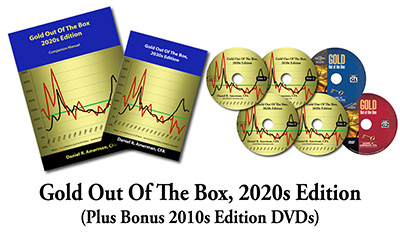
Watch The 2020s Edition Online
Learn more about the contracyclical strategies for gold and stocks, brochure link here.






